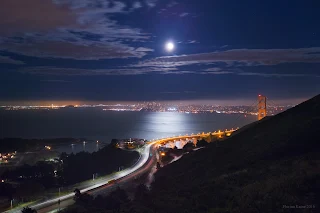When Google launched Pixel and Pixel XL they bragged about it's stunning camera that can produce excellent pictures thanks to its HDR+ mode. While smartphone photography has excelled in recent years thanks to these techniques, there are still some limitations.
Today, one of the Googler pushing the boundaries of what’s possible and experimented with capturing low-light shots with the Nexus 6P and Pixel. The resulting nighttime photography, though requiring heavy post-processing, is comparable to a DSLR.
The story is very interesting and I recommend you hit up the source link at the bottom of this post to read the full thing. However, if you don’t have time, the basics are this. Florian Kainz, who previously worked on the Gcam team at Google Research, created his own Android camera app that allowed him to manually control exposure time, ISO, and focus distance. Then, he would setup the app on a Pixel or Nexus 6P, point at his subject, and press the shutter button.
From there, after a brief pause, the cameras would produce bursts of shots with few-second exposure times. He would then take those batches of photos and process them on a computer into the photos we featured here. Similar to the principles behind HDR, up to 64 frames are captured.
The app saves the raw frames from the sensor as DNG files for later editing on a PC. For the moment, editing is the most important step in achieving the excellent photos. You can see the gallery at the end of the article.
This experiment shows that phone cameras are “suitable” for outdoor nighttime photography. While post-processing on a desktop computer is currently required, Kainz believes that phones should one day be able to process images on-device.
Either way, read the story and then dive into some of these amazing photos. Full gallery can be found here.
Source : Google Research Blog
Today, one of the Googler pushing the boundaries of what’s possible and experimented with capturing low-light shots with the Nexus 6P and Pixel. The resulting nighttime photography, though requiring heavy post-processing, is comparable to a DSLR.
The story is very interesting and I recommend you hit up the source link at the bottom of this post to read the full thing. However, if you don’t have time, the basics are this. Florian Kainz, who previously worked on the Gcam team at Google Research, created his own Android camera app that allowed him to manually control exposure time, ISO, and focus distance. Then, he would setup the app on a Pixel or Nexus 6P, point at his subject, and press the shutter button.
From there, after a brief pause, the cameras would produce bursts of shots with few-second exposure times. He would then take those batches of photos and process them on a computer into the photos we featured here. Similar to the principles behind HDR, up to 64 frames are captured.
The app saves the raw frames from the sensor as DNG files for later editing on a PC. For the moment, editing is the most important step in achieving the excellent photos. You can see the gallery at the end of the article.
The individual frames were very grainy, as one would expect given the tiny sensor in a cellphone camera, but computing the mean of all 32 frames cleaned up most of the grain, and subtracting the mean of the 32 black frames removed faint grid-like patterns caused by local variations in the sensor’s black level. The resulting image, shown below, looks surprisingly good.Kainz also successfully took shots of a nighttime landscape featuring stars, as well as shots with minimal to no lighting from the moon.
This experiment shows that phone cameras are “suitable” for outdoor nighttime photography. While post-processing on a desktop computer is currently required, Kainz believes that phones should one day be able to process images on-device.
Pixel
Nexus 6P
Either way, read the story and then dive into some of these amazing photos. Full gallery can be found here.
Source : Google Research Blog








0 Comments